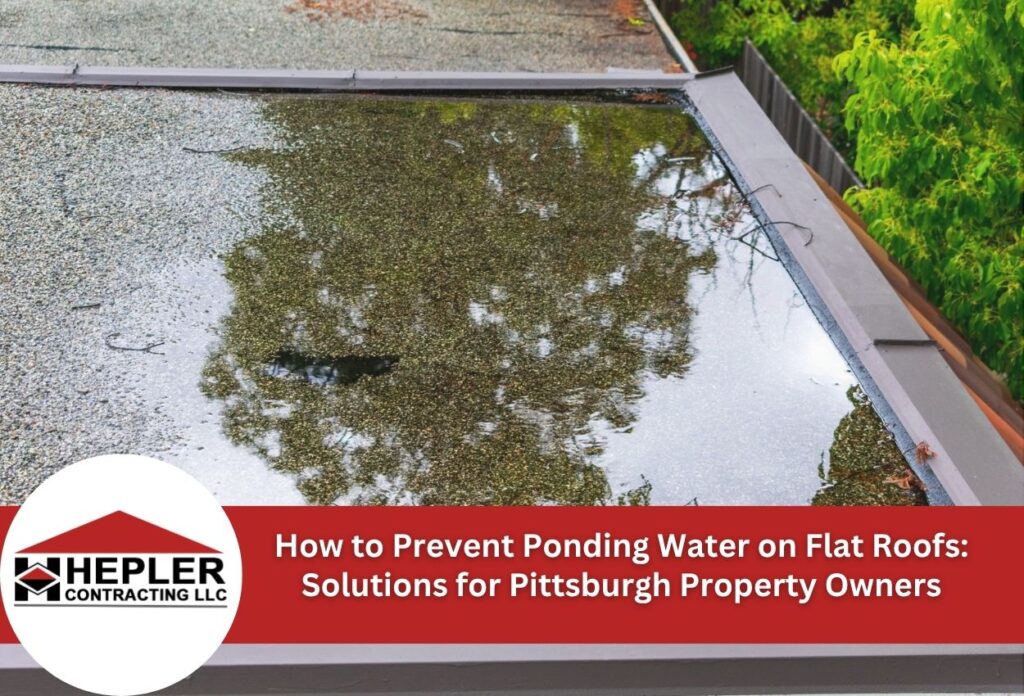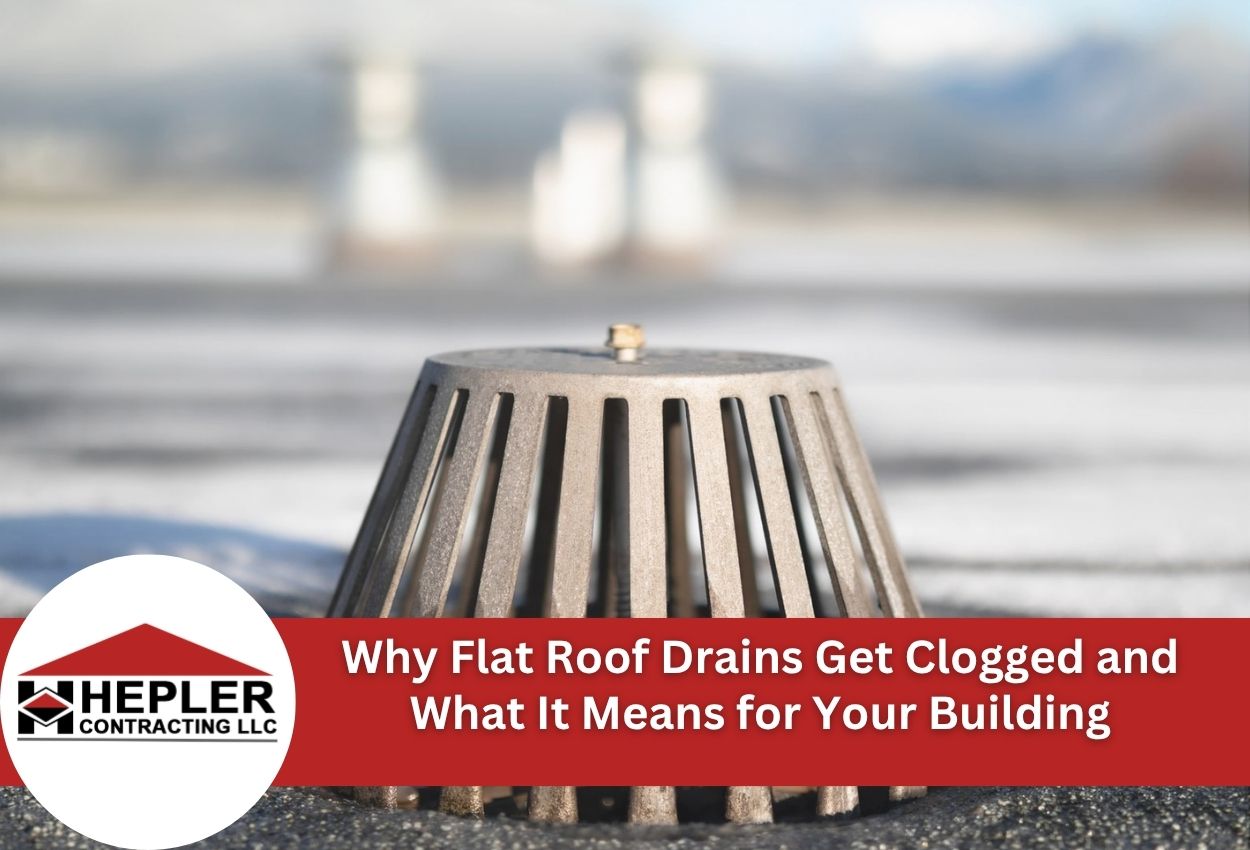Flat roofs are common on commercial buildings and some residential properties throughout Pittsburgh, but they face a persistent challenge: ponding water. This occurs when water collects and remains on a roof for more than 48 hours after rainfall has stopped. Pittsburgh’s climate, with its abundant rain and heavy winter snowfall, makes local buildings particularly vulnerable to this problem.
When water sits on a flat roof, it creates significant risks. The weight of ponding water puts excess strain on the roof structure, potentially causing sagging that creates even deeper pools. This standing water accelerates the deterioration of roofing materials, shortening the roof’s lifespan. During freeze-thaw cycles common in Pittsburgh winters, ponding water expands when frozen, creating cracks and openings where leaks can develop.
The consequences of ignoring this issue can be severe. Beyond structural damage, ponding water often leads to moisture penetration, interior water damage, mold growth, and expensive repairs. For Pittsburgh property owners, implementing effective flat roof drainage solutions is not just about maintenance — it’s about protecting their entire building investment.
Eliminating standing water on commercial roofs requires understanding both prevention strategies and remediation techniques. From improving roof slope for better water runoff to installing appropriate drainage systems, several proven approaches can keep flat roofs dry and functional for years to come.
Understanding the Causes of Flat Roof Ponding
Flat roof ponding issues stem from several key structural factors that Pittsburgh property owners should recognize. Inadequate roof design is often the primary culprit, with insufficient slope being the most common problem. While truly “flat” roofs actually require a minimum pitch of 1/4 inch per foot for proper drainage, many older Pittsburgh commercial buildings were constructed with less slope or have lost their effective pitch over time.
Building settlement is another significant concern. As structures age, foundations may shift unevenly, particularly in Pittsburgh’s hilly terrain where soil conditions vary widely. This settlement can create low spots where water naturally collects. Additionally, poorly positioned or inadequate drainage systems, including clogged drains, insufficient scuppers, or improperly sized downspouts, prevent water from efficiently leaving the roof surface.
Pittsburgh’s climate creates perfect conditions for ponding problems. The region receives approximately 38 inches of annual rainfall, meaning roofs stay wet frequently. Winter brings another challenge as snow accumulation melts gradually, creating persistent moisture. The freeze-thaw cycles characteristic of Pittsburgh winters exacerbate ponding by causing micro-movements in the roof structure that can create depressions.
Local buildings face different challenges compared to those in drier regions, making regular roof maintenance critical. Professional roof inspections can identify early signs of ponding and address underlying structural issues before they lead to major damage and repairs.
Drainage Systems: The Foundation of Ponding Prevention
Effective drainage systems are the primary solution for preventing water accumulation on flat roofs. For Pittsburgh property owners, installing the right drains can be the difference between a long-lasting, durable roof and one with constant problems. Interior drains work by creating strategically placed openings in the roof surface that connect to internal drainage pipes. These systems are excellent for large commercial buildings as they efficiently remove water from expansive roof areas and protect drainage components from Pittsburgh’s harsh winter conditions.
Scuppers offer another solution, particularly for buildings with parapet walls. These openings in the roof edge allow water to flow directly off the roof instead of pooling. For optimal performance in Pittsburgh’s rainy climate, scuppers should be placed at the lowest points of the roof and sized appropriately for local precipitation volumes. Gutters and downspouts form the third major drainage option, collecting water at roof edges and channeling it safely to the ground.
When determining the appropriate number of drainage points, Pittsburgh roofing professionals consider several factors, with the roof’s square footage serving as the primary calculation basis. Local precipitation patterns also influence this equation, with Pittsburgh’s average rainfall requiring more drainage capacity than drier regions. The roof’s configuration, including existing low spots and structural elements, further guides drain placement to ensure complete water removal.
Creating and Improving Roof Slope for Effective Water Runoff
Even existing flat roofs with ponding issues can be modified to achieve proper water drainage. For Pittsburgh building owners facing persistent standing water problems, tapered insulation systems offer an excellent retrofit solution. These systems consist of insulation boards cut at precise angles to create a gradual slope toward drainage points, effectively transforming a problematic flat surface into one that naturally channels water away.
Crickets provide another targeted solution for particularly troublesome areas. These triangular-shaped elevated sections can be installed between drains or around rooftop equipment to prevent water from collecting in these common problem spots. Made from compatible roofing materials, crickets redirect water flow without requiring complete roof replacement — an affordable fix for Pittsburgh commercial properties.
Professional Pittsburgh roofers approach slope improvements methodically, beginning with roof assessments using specialized equipment to identify the exact locations and depths of ponding areas. This precision measurement allows them to calculate the specific slope requirements for each section of the roof. Based on these findings, roofers develop customized solutions that address the ponding patterns of each building.
The type of existing roof membrane significantly influences the approach to slope improvement. EPDM rubber roofs may accommodate overlay solutions, while TPO or modified bitumen systems might require different techniques. A qualified Pittsburgh roofing contractor will evaluate structural load capacity before adding materials to ensure the building can safely support the additional weight of slope-creating systems.
Membrane Selection and Installation Techniques to Combat Ponding
Choosing the right roofing membrane is critical in preventing ponding water on flat roofs, especially in Pittsburgh’s challenging climate. TPO (thermoplastic polyolefin) membranes offer excellent resistance to ponding water and UV exposure, with heat-welded seams that create a watertight barrier. EPDM rubber membranes provide exceptional elasticity and durability, making them capable of withstanding constant water exposure, though their seams require special attention during installation to prevent potential leak points.
PVC membranes stand out for their superior chemical resistance and perform exceptionally well in areas with prolonged standing water. Their hot-air welded seams create molecular bonds that remain watertight even under constant moisture. Modified bitumen systems, with their multiple layers and reinforcement, offer robust protection against ponding but require expert installation to maximize their water-resistant properties.
The installation techniques used are just as important as the material you choose. Professional Pittsburgh roofers pay careful attention to seam construction, ensuring overlaps are correctly sized and thoroughly sealed according to manufacturer specifications. Penetration details around vents, HVAC equipment, and other roof elements require meticulous flashing installation with appropriate sealants to prevent water infiltration at these vulnerable points.
Edge terminations also need specific care, as water naturally flows toward roof perimeters. Properly secured termination bars, edge metal, and counterflashing prevent water from migrating under the membrane. For optimal ponding resistance in Pittsburgh, these installation details must be executed with precision by experienced roofing professionals.
Routine Maintenance Practices to Prevent Water Accumulation
Consistent maintenance is essential for preventing ponding water on flat roofs, especially in Pittsburgh. Implementing a structured maintenance program can significantly extend roof lifespan and prevent expensive water damage. During spring, clearing debris from drains, scuppers, and gutters removes winter accumulation and prepares the roof for heavy rainfall. Summer maintenance should focus on checking roof membranes for early signs of deterioration and ensuring drainage paths remain unobstructed during storm season.
Fall brings specific maintenance needs as Pittsburgh’s trees shed leaves that can quickly clog drainage systems. Regular cleaning before winter arrives is crucial, as is checking that all drainage components are functioning properly. Winter maintenance requires special attention to snow removal and ice management. When safe to do so, clearing heavy snow accumulation prevents excessive weight and subsequent melt ponding, while checking for and addressing ice dams around drainage points ensures water can escape when temperatures rise.
Professional roof inspections play a vital role in ponding prevention. Pittsburgh roofing contractors have the expertise to spot subtle issues like minor depressions or early membrane deterioration that property owners might miss. By identifying and addressing small problems, property owners can avoid the significant expense and disruption of major roof repairs or premature replacement due to water damage.
Advanced Solutions for Persistent Ponding Problems
When standard drainage improvements aren’t enough to solve stubborn ponding issues on Pittsburgh flat roofs, more sophisticated solutions become necessary. Roof pumps offer an effective mechanical option for buildings with structural limitations that prevent proper drainage. These systems automatically detect water accumulation and actively remove it, making them ideal for older Pittsburgh commercial buildings where adding slope isn’t structurally feasible.
Siphonic drainage systems represent another technological advancement that can transform flat roofs. Unlike traditional gravity-based drainage, these systems create a full-bore flow that rapidly removes water significantly faster than conventional methods. For large commercial properties throughout Pittsburgh’s business districts, this technology can eliminate ponding even during the heaviest downpours.
Green roof installations provide a dual-purpose solution that addresses ponding while offering environmental benefits. These systems use vegetation and soil to absorb rainfall, substantially reducing runoff volume. The plants and substrate naturally filter water while providing insulation that can lower energy costs for Pittsburgh buildings. While requiring a higher initial investment, green roofs may qualify for incentives that offset costs.
When deciding between remediation and replacement, property owners should consider roof age, extent of water damage, and long-term objectives. A qualified Pittsburgh roofing contractor can provide guidance on whether targeted solutions will suffice or if a complete system redesign offers better value. Sometimes, investing in a comprehensive replacement with proper slope and modern drainage is better than repeated repairs to a fundamentally flawed system.
Protect Your Flat Roof with Hepler Contracting LLC
If you’re dealing with persistent ponding on your flat roof despite trying conventional methods, it might be time to consider advanced solutions. At Hepler Contracting LLC, we specialize in innovative techniques to effectively manage water on problematic flat roofs. These solutions are particularly beneficial in Pittsburgh’s demanding climate, ensuring your roof withstands heavy rainfall and snow without succumbing to water damage.
Don’t let ponding water compromise your property’s integrity. For expert guidance and advanced roof drainage solutions, call Hepler Contracting LLC at (412) 694-8785 today. Our team is ready to assess your specific needs and provide tailored, long-lasting solutions to keep your roof dry and damage-free.




